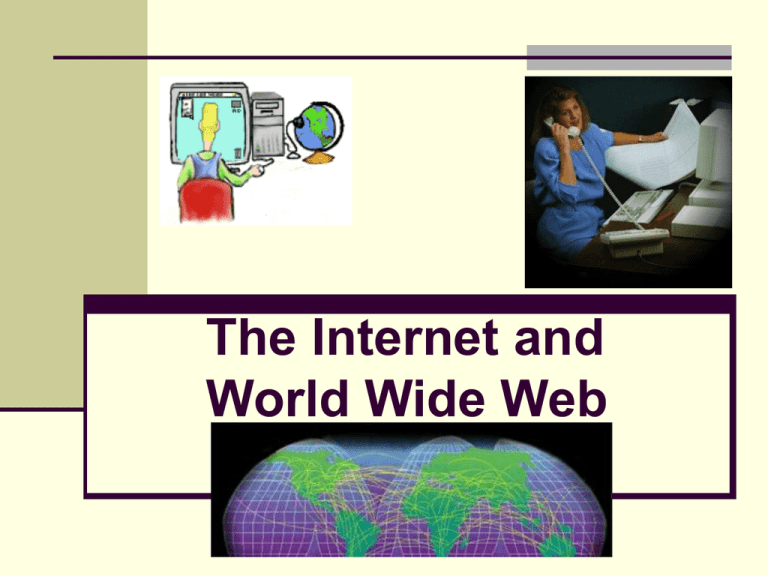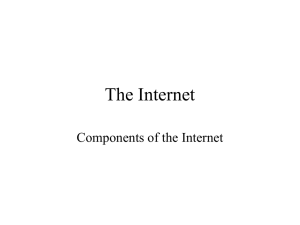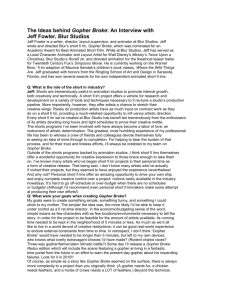The Internet and the WWW - Request a Spot Account | PCC
advertisement

The Internet and World Wide Web The Internet What are some services found on the Internet? (1) (4) (3) (2) (5) (6) e-mail (1) chat (4) Web (2) message board (5) file transfer (3) instant messaging (6) History of the Internet How did the Internet originate? ARPANET Goal: To allow scientists at different locations to share information Networking project by Pentagon’s Advanced Research Projects Agency (ARPA) Goal: To function if part of network were disabled Became functional September 1969 During the Cold War there was concern about connectivity in the event of a nuclear attack History of the Internet Early 1960’s Packet-switching envisioned (Baran and Davies) Divide a message into a smaller pieces called packets. Each packet contains where they came from and the address of where they are going. Each packet is sent to its destination separately. Provided the foundation for what became the Internet. History of the Internet ARPANET (Advanced Research Projects Agency NETwork) Funded by ARPA. Pooled computer scientists and resources from several universities. In 1969, linked 4 nodes at UCLA, UC Santa Barbara, SRI (Stanford Research Institute) and Univ. of Utah. By mid-1970’s, linked several military sites and about 20 universities. History of the Internet NSF (National Science Foundation) In 1980, started CSnet. Provided a resource sharing network for computer science research at all universities. Used TCP/IP protocol – the government gave it away – it is in the public domain – no charge for its use – UNIX based. History of the Internet In 1989, majority of ARPANET switched to NSF’s backbone. Became what is known as the Internet. Early 1995, the Internet became known as the “Information Superhighway.” History of the Internet How has the Internet grown? Today More than 100 million host nodes 1984 More than 1,000 host nodes 1969 Four host nodes History of the Internet Who provides the Internet’s structure today? Networks from corporations, commercial firms, and other companies Telephone companies Satellite companies Cable companies Government History of the Internet Who controls the Internet? Nobody; it is public, cooperative, and an independent network Several organizations set standards World Wide Web Consortium (W3C) • Oversees research, sets standards and guidelines • Tim Berners-Lee, director Internet2 (I2) • Internet-related research and development project • Develops and tests advanced Internet technologies How the Internet Works What are ways to access the Internet? 1 Regional ISP 2 National ISP 3 OSP (Ex. AOL) 4 Wireless Internet Service Provider 2 1 local call long-distance call local call 3 local call toll-free call 4 local call How the Internet Works How can you connect to the Internet? Very high-speed connection T-1, Fiber Optic Digital subscriber line (DSL) and cable modem Dial-up access How the Internet Works What are three parts of an Internet connection? Client (Your computer) Backbone (Communication Lines) Server (Host computers) How the Internet Works 1: RHow equest datadata fromtravel the the Internet using a telephone line connection? might a server on Internet. 2: Modem converts digital signals to analog signals. 3: Data travels through Regional ISP Step 3 Step 5 Step 1 telephone lines to a local ISP. 4: Data passes through routers. Step 2 Step 4 National ISP 5: Regional ISP uses leased lines to send data to a national ISP. Local ISP 6: National ISP routes data across the country. 7: National ISP passes data to local ISP. 8: Server sends data back to you. Step 6 Internet backbone Step 8 Step 7 National ISP How the Internet Works Internet owes its original critical mass to the wide distribution of computers running the UNIX operating system. With the thousands of computers running the UNIX operating system, and freely distributed TCP/IP software suite: Original access to the Internet had UNIX “feel.” Exact addresses were needed to access information. Addresses were strings of numbers Address for www.yahoo.com = 204.71.200.68 You can find the Web server IP address by pinging the site at the DOS command prompt. UNIX gurus “ran the net.” They loved the degree of exclusivity due to the difficulty of use. This difficulty changed with development of “Gopher” and later the WWW. How the Internet Works What is an Internet protocol (IP) address? Number that uniquely identifies each computer or device connected to Internet IP address 199.95.72.10 first part identifies network last part identifies specific computer How the Internet Works Networks using the TCP/IP protocol route messages based on the IP address of the destination. Format of an IP address is a 32-bit numeric address written as four numbers separated by periods. Each number can be zero to 255. For example, 1.160.10.240 could be an IP address. An isolated network, you can assign IP addresses at random as long as each one is unique. Connecting a private network to the Internet requires using registered IP addresses (called Internet addresses) to avoid duplicates. The four numbers in an IP address are used in different ways to identify a particular network and a host on that network. How the Internet Works The InterNIC Registration Service assigns Internet addresses from the following three classes: Class A - supports 16 million hosts on each of 127 networks Beginning bit pattern 0 Class B - supports 65,000 hosts on each of 16,000 networks Beginning bit pattern 10 (10000000 10011100 00001110 00000111) translates to 128.156.14.7 Class C - supports 254 hosts on each of 2 million networks Beginning bit pattern 110 The current standard is the 32 bit IPv4 IP addressing system. The number of unassigned Internet addresses is running out, so a new classless scheme called CIDR (Classless Inter-Domain Routing) is gradually replacing the system based on classes A, B, and C and is tied to adoption of IPv6, short for Internet Protocol next generation. IPv6 solves IPv4 address limitation by extending addressing from 32 to 128 bits. How the Internet Works You can test your connection to a site (server computer) by using the ping command at the DOS prompt followed by the URL of the site. For example, you can ping Yahoo as follows: C:\>ping www.yahoo.com The result will indicate if there is a connection, how long it took to reach the site round trip and what is the IP address of the site server. How the Internet Works How the Internet Works How the Internet Works TRACEROUTE: a program primarily designed as a network debugging and analysis tool and is a part of most operating systems. In Microsoft’s Windows 9x, it’s name has been altered to TRACERT. The purpose of this tool was to allow the tracing of the packets over the Internet or any network using TCP/IP protocol. Observing how the program functions helps to shed light on how packet switching works. TRACERT uses a special number called the TTL (Time To Live) number contained in a place at the beginning of each packet sent over the network. The number is originally set to 255 and each time the packet is received by a router along the way to its destination the number is decremented, usually by 1. If the TTL reaches 0 before the packet reaches its destination and error message is sent back to the original sender. The TTL number prevents packets from circulating forever on the network. You can use TRACERT, at the DOS prompt, to trace the route from your computer to the Yahoo site server as follows: C:\>TRACERT www.yahoo.com How the Internet Works How the Internet Works You can find the IP address of your computer by going to: Start – Run then in the Open box type winipcfg and press Enter. The results will be similar to the box below for 98, Me, 2000: Windows XP looks different How the Internet Works How IP addresses are normally assigned by an ISP Most IP addresses are assigned randomly and automatically through a DHCP server. DHCP is short for Dynamic Host Configuration Protocol, a protocol for assigning dynamic IP addresses to devices on a network. With dynamic addressing, a device can have a different IP address every time it connects to the network. Dynamic addressing simplifies network administration because the software keeps track of IP addresses rather than requiring an administrator to manage the task. How the Internet Works What is a domain name? Text version of IP address IP address Domain name 199.95.72.10 scsite.com How the Internet Works Domain Name System (or Service), an Internet service that translates domain names into IP addresses. Because domain names are alphabetic, they're easier to remember. The Internet is really based on IP addresses. Every time you use a domain name, therefore, a DNS service must translate the name into the corresponding IP address. For example, the domain name www.example.com might translate to 198.105.232.4. The World Wide Web What is a URL? (Uniform Resource Locator) Unique address for Web page located on Web server protocol domain name path http://www.nationalgeographic.com/travel/index.html The World Wide Web A Uniform Resource Locator (URL) has 3 parts: 1) Type of connection (specifies protocol used at that location): Name HTTP FTP SMTP FILE Gopher WAIS Telnet Definition HyperText Transport Protocol File Transfer Protocol Email Protocol Local file access Name of Internet access system Wide area info. Service Telephone Networking Description Mode through which WWW uses the Internet. Used for transferring files between computers. Used to send/create an email link. Used to view HTML files. Transfer type used by Gopher systems. Tool for searching information databases. Service for logging on to remote computers. The majority of Web sites use http protocol, but you may see some of the others while surfing the Web. The World Wide Web 2) The Internet address of the computer you are trying to access: (Locates the specific computer on the Internet.) Type of connection Top-level Domain Path or Directory http://www.eds.com/home/eds_home.html Domain Domain name: Identifies the Internet address Top-level Domain: Identifies the type of organization File name Com edu gov mil net org Commercial site Educational Institution Government organization Military organization Networking organization Nonprofit organization The World Wide Web ICANN (Internet Corporation for Assigned Names and Numbers), a nonprofit group governing domain names, was created by the late Jon Postel in the fall of 1998 in response to a policy statement issued by the US Department of Commerce. ICANN oversees the domain-name registration system's transition from government hands to private hands and to coordinate the its decentralization and integration into a global community. The board of directors of ICANN has approved seven new top suffixes. The new domain names are the first major additions since the system was developed in the 1980s. The new domain name suffixes will compete with the seven existing domain name types, which include .net, .com, .org, .gov, .mil, and .edu. The new suffixes appeared in use around mid-2001. It is similar to adding area codes to the national phone system to accommodate growth. The new suffixes can be grouped into three categories: General purpose -- .biz, .info Personal -- .name Restricted use by community -- .aero, .coop, museum, and .pro. Additionally, countries have two digit designations, such as, de Germany, fr France, sg Singapore, ws Samoa and so on. The World Wide Web Domain name registration: How can I determine whether the name I want is available? Most domain name registering companies have a place for you to enter the domain name you want and then search to see if it is available. Thousands are registered each day. Some domain name registration services are: www.networksolutions.com And many others. www.domainmart.com Who is InterNIC? InterNIC is the only organization that maintains the database of information related to a domain name under .com, .net, .org, and .edu. Registrations, renewals, and modifications to any of the information on the Whois database have to be processed through them. Under the current agreement with the U.S. Government, InterNIC, Inc., as the InterNIC, provides domain name registration services in .com, .net, .org, and .edu. The World Wide Web The usual cost to register a domain name is $35 per year. Many registration companies have specials for less and also offer Web page hosting and design services packages. Some Web sites offer free hosting: Yahoo and Geocities for example Most ISPs offer some amount of free Web space (typically 6 to 10MB, but some up to 50MB) with your subscription to their services. However, they may not allow the use of a domain name, such as, www.something.com, etc. The World Wide Web 3) The path and name of the file: Identifies the location of the file and the name of the file to be displayed on your screen. If the path (folder or subdirectory) or name of file have been changed: An error message will appear on your screen! This error typically occurs when a page has been moved, renamed, or deleted. A way around this may be to gradually shorten the URL until a valid Web page appears. http://www.example.com/website/document.html http://www.example.com/website/ http://www.example.com/ The World Wide Web What is the World Wide Web (WWW) ? A worldwide collection of electronic documents Also called the Web Each document is called a Web page Can contain text, graphics, sound, video, and links to other Web pages A Web site is a collection of related Web pages The World Wide Web Internet needed improvements in user-friendliness. Three early creations satisfied the need: Gopher Veronica Archie Gopher (University of Minnesota): Land of the “Golden gophers.” Introduced first improvement to accessing the Internet. Menu-driven system gave access to databases of information. There were once over 5,000 gopher servers. Still used for text based information. The World Wide Web Gopher menu for accessing the Internet Internet Gopher Information Client v2.1.3 Home Gopher server: gopher.tc.umn.edu 1. 2. 3. 4. 5. 6. 7. 8. 9. 10. 11. 12. Information About Gopher/ Computer Information/ Discussion Groups/ Fun & Games/ Internet file server (ftp) sites/ Libraries/ News/ Other Gopher and Information Servers/ Phone books/ Search Gopher Titles at the University of Minnesota <?> Search lots of places at the university of Minnesota <?> University of Minnesota Campus Information/ Press ? For Help, q to Quit, u to go up a menu The World Wide Web World Wide Web (WWW or The Web) A computer communications system that allows multimedia information to be accessed and transmitted via the Internet. It is an application that runs on the Internet. The Web follows the Hypertext Transfer Protocol (HTTP). Developed in 1989 by Tim Berners-Lee, a physicist at the European high-energy physics laboratory in Switzerland. Remember a protocol is a set of rules implemented in a program. Allows an individual computer to participate with other computers through the Internet. Converts text, visual and audio information into packets to traverse the Internet. Much better than the text only basis of Gopher. Multimedia communication is more effective, easier to understand by more people and conveys more information. The World Wide Web What is a Web browser? Program that allows you to view Web pages • Netscape • Internet Explorer • Opera The browser reads the HTML code and builds the Web page. The World Wide Web HTML - HyperText Markup Language, the authoring language used to create documents on the World Wide Web. HTML defines the structure and layout of a Web document by using a variety of tags and attributes. The correct structure for an HTML document starts with <HTML> <HEAD> <TITLE>(enter here what document is about)</TITLE> </HEAD> <BODY> and ends with </BODY> </HTML>. All the information you'd like to include in your Web page fits in between the <BODY> and </BODY> tags. There are hundreds of other tags used to format and layout the information in a Web page. Tags are also used to specify hypertext links. There are many HTML and Web authoring sites on the Internet, just do a search. The World Wide Web An example of HTML code and the page it produces. Next p. 2.9 The World Wide Web How do handheld computers and cellular telephones access the Web? Must be Web- enabled Uses a microbrowser that displays Web pages that contain mostly text Microbrowser for a Web-enabled cellular telephone Microbrowser for a Webenabled handheld computer The World Wide Web What is a hyperlink? Text or graphic that displays a related Web page Also called a link The World Wide Web How can you identify a hyperlink (link) on a Web page? Mouse pointer changes to a small hand when you point to a link Click the link to display the associated Web page Link can be a word, mouse pointer changes to phrase, or image small hand The World Wide Web What is a search engine? Program used to find Web pages pertaining to a specific topic Search text Spider Word or phrase entered in search engine’s text box Program used by search engines to find Web pages that contain search text Also called a keyword Also called a crawler or bot The World Wide Web What are some widely used search engines? The World Wide Web What is a directory? Search tool with organized set of topics and subtopics Lets you find information by clicking links rather than entering keywords organized topics from which you select The World Wide Web What are graphic file formats? The World Wide Web What is a thumbnail? Small version of a larger graphical image Usually click thumbnail on Web page to display full-sized image full-sized image Web Publishing How do you deploy a Web site? Locate Web server to store your site Upload, or copy, site to Web server Other Internet Services What is FTP? File Transfer Protocol Internet standard that allows you to upload and download files with other computers on Internet file downlo dialog box Other Internet Services What is a newsgroup? Online area where users conduct written discussions about particular subject User sends message to newsgroup Other users in newsgroup read and reply to message Usenet Entire collection of Internet newsgroups News server Computer that stores and distributes newsgroup messages Other Internet Services What is a message board? Type of discussion group that does not require newsreader Also called a discussion board link to message about financial issues Other Internet Services What is a chat? Real-time conversation that takes place on a computer Chat room is location on server that permits users to discuss topics of interest Other Internet Services What is instant messaging (IM)? A real-time Internet communications service Marianne’s message immediately displays on Jeff’s computer screen because she is online message sent from Marianne to Jeff Jeff’s response to Marianne The Internet and World Wide Web THE END




